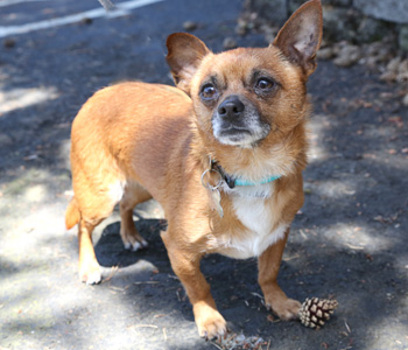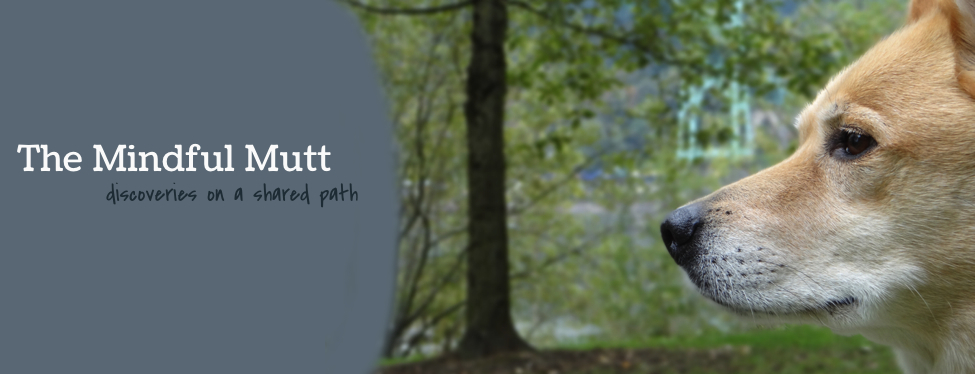The downside of luring a fearful dog
 Thursday, June 21, 2012 at 2:29PM
Thursday, June 21, 2012 at 2:29PM  Here's another counterintuitive idea, one I've taken a long time and many mistakes (some quite recent) to appreciate. I'm generally a big fan of "free shaping," a training method that marks and rewards successive approximations of a desired behavior (or, at its freest, a behavior that the dog invents). Free shaping requires patience, but it can really "light up" a dog, as it engages her initiative, intelligence, and pleasure in learning. That said, I haven't been a purist in this regard; I'll often resort (and encourage my students to resort) to the use of food lures to jump start behaviors when time and/or patience are at a premium. (To begin to teach "down" from a sit, for instance, it's common to take a good, smelly treat and use it to draw a dog's nose down, then out along the floor in an L-motion.)
Here's another counterintuitive idea, one I've taken a long time and many mistakes (some quite recent) to appreciate. I'm generally a big fan of "free shaping," a training method that marks and rewards successive approximations of a desired behavior (or, at its freest, a behavior that the dog invents). Free shaping requires patience, but it can really "light up" a dog, as it engages her initiative, intelligence, and pleasure in learning. That said, I haven't been a purist in this regard; I'll often resort (and encourage my students to resort) to the use of food lures to jump start behaviors when time and/or patience are at a premium. (To begin to teach "down" from a sit, for instance, it's common to take a good, smelly treat and use it to draw a dog's nose down, then out along the floor in an L-motion.)
I'd like to take these shortcuts less often, but I haven't known them to be harmful or problematic in most run-of-the-mill training situations, as long as the lure is faded quickly and the dog kept mentally active. (Too much luring can lead to a kind of "passenger seat" phenomenon - have you ever been driven somewhere three or more times with nothing on your mind but the passing scenery and the fun you'll have when you arrive at your destination, then gotten lost when you had to drive there yourself? The same thing often happens with a dog whose focus is totally consumed by a moving treat.)
As harmless as luring generally is with a confident dog learning basic behaviors, it can backfire badly when used to encourage a fearful dog to "overcome" its fear, and I've become convinced that we should avoid it whenever possible.
The reasoning behind luring a fearful dog collapses the logic of classical conditioning (developing habits of association) with the logic of operant conditioning (developing habits of behavior). If I use the scent and sight of something delicious to draw a fearful dog toward me, my hope is that the dog will not only learn to approach what it fears (me), but also that I'll become less scary as I become more strongly associated with good stuff. In theory, this approach seems like it could be doubly powerful, but in practice it can create serious, even dangerous difficulties.
When luring a confident and physically sound dog in order to sketch out a new behavior, I'm not asking the dog to overcome anything but his ignorance of what he needs to do to get the treat he wants. Imagine instead that the dog were badly arthritic and I tried to lure him to do something physically painful. It wouldn't be surprising if the dog simply balked. Imagine that I offered a series of progressively more tempting treats, until I found the one that "worked" (a bit of steak, say), that is, the one that allowed me to override the dog's strong instinct toward self-preservation. I would not have used "force" as it's commonly understood, but it's doubtful that the dog would now be more likely to perform the desired behavior. And multiple repetitions of this "bargain" could well create an association between steak and pain.
A dog riddled by pain and a dog riddled by fear share an especially strong need for autonomy; their great vulnerability naturally heightens their desire to be in control of themselves and their immediate surroundings. For a fearful dog, distance (between the dog and the object of her fear) is often the most critical variable determining her relative sense of comfort, and giving her control of that variable is often the most effective way to boost her confidence, especially if control itself is paired with other good stuff, and the feared object is the source (or the predictor) of that good stuff.
How to do this? One of the simplest and most effective methods I've found for ameliorating a dog's fear of humans is the "Treat and Retreat" exercise developed by Suzanne Clothier and Ian Dunbar. I should say "exercises," since trainers have invented many variations on the theme, but the principle remains the same: rather than luring the dog toward you (by offering the treat ahead of time and using it to draw the dog in), you reward any independent choice by the dog to approach (even the tiniest and most hesitant) with both a food treat and increased distance. My favorite way of doing this is to mark (with a quiet "yes") a dog's approach (or a lean forward, or even an inkling of interest) and toss the treat past her (gently and underhand). She has already established the distance at which she feels just safe enough; when she goes for the treat, the pressure of my frightening presence is relieved (though she may be reluctant to turn her back on me). Having moved further away, she is then set up to move back toward me to her original safe distance, a choice I'll mark and reward again in the same way.
As she comes to understand that she's in full control of the distance between us, and as she comes to think of me as a treat (and security!) dispensing machine, she'll draw closer at her own pace. And I will never have put her in the bind of choosing between nourishment and safety.




